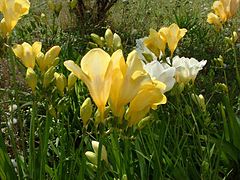This is an old revision of this page, as edited by 88.17.79.216 (talk) at 15:49, 29 April 2007 (→References). The present address (URL) is a permanent link to this revision, which may differ significantly from the current revision.
Revision as of 15:49, 29 April 2007 by 88.17.79.216 (talk) (→References)(diff) ← Previous revision | Latest revision (diff) | Newer revision → (diff)
| Freesia | |
|---|---|

| |
| Cultivated freesias | |
| Scientific classification | |
| Kingdom: | Plantae |
| Division: | Magnoliophyta |
| Class: | Liliopsida |
| Order: | Asparagales |
| Family: | Iridaceae |
| Genus: | Freesia Klatt |
| Species | |
|
See text. | |
Freesia (Ecklon ex Klatt) is a genus of 14-16 species of flowering plants in the family Iridaceae, native to Africa. Of the 14 species, 12 are native to Cape Province, South Africa, the remaining two to tropical Africa, one species extending north of the equator to Sudan.
The genus was named in honor of Friedrich Heinrich Theodor Freese (1795-1876), German physician.
They are herbaceous plants which grow from a corm 1-2.5 cm diameter, which sends up a tuft of narrow leaves 10-30 cm long, and a sparsely branched stem 10-40 cm tall bearing a few leaves and a loose one-sided spike of fragrant narrowly funnel-shaped flowers.
- Species
- Freesia alba
- Freesia andersoniae
- Freesia caryophyllacea
- Freesia corymbosa
- Freesia fergusoniae
- Freesia fucata
- Freesia grandiflora
- Freesia iwuzhere
- Freesia laxa (syn. Anomatheca laxa, Lapeirousia laxa)
- Freesia leichtlinii
- Freesia occidentalis
- Freesia refracta
- Freesia sparrmannii
- Freesia speciosa
- Freesia verrucosa
- Freesia viridis (syn. Anomatheca viridis)
Freesias are used as food plants by the larvae of some Lepidoptera species including Large Yellow Underwing.
Cultivation and uses
Freesias are very popular garden plants, grown for their often strongly scented flowers. The most commonly cultivated species is F. refracta, which was crossed with F. leichtlinii in the 19th century. Numerous cultivars have been bred from these species and the pink- and yellow-flowered forms of F. corymbosa. Modern tetraploid cultivars have flowers ranging from white to yellow, pink, red and blue-mauve. They are widely cultivated and readily increased from seed. Due to their specific and pleasing scent, they are often used in hand creams, shampoos, candles, etc.
References
Goldblatt, P. (1982) Systematics of Freesia Klatt (Iridaceae) J. South African Bot. 48:39-93.
- info and pictures
- Bulbsociety: Freesia
- PlantZAfrica: Freesia
- Iziko Museum, South Africa: Freesia
- Freesias info and pictures